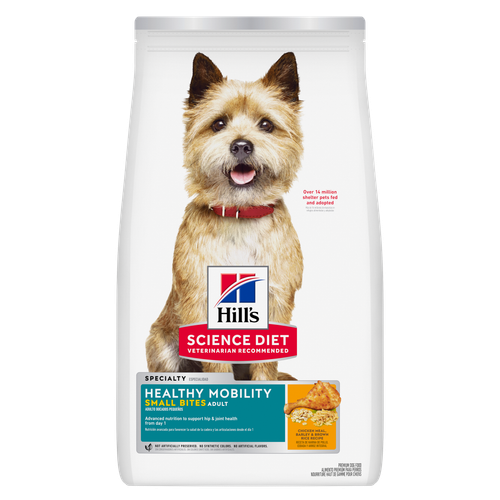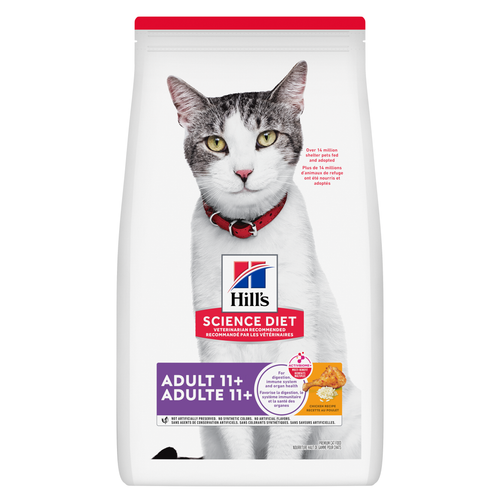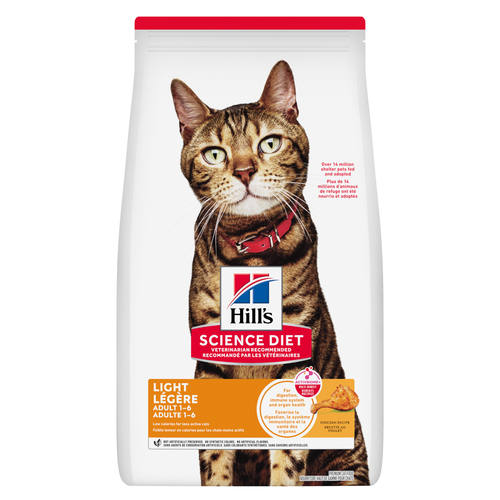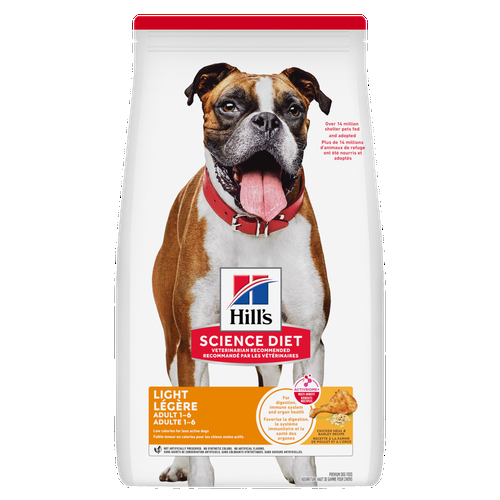
-
Find the right food for your petTake this quiz to see which food may be the best for your furry friend.Find the right food for your petTake this quiz to see which food may be the best for your furry friend.Featured products
 Adult Sensitive Stomach & Skin Small & Mini Chicken Recipe Dog Food
Adult Sensitive Stomach & Skin Small & Mini Chicken Recipe Dog FoodHill's Science Diet Sensitive Stomach & Skin Small & Mini dry dog food is tailored nutrition for Small & Mini dogs while being gentle on stomachs. Nourishes skin & promotes a lustrous coat.
Shop Now Adult Healthy Mobility Small Bites Chicken Meal, Barley & Brown Rice Recipe Dog Food
Adult Healthy Mobility Small Bites Chicken Meal, Barley & Brown Rice Recipe Dog FoodAdvanced nutrition to support hip & joint health from day 1
Shop Now Adult Light Large Breed Chicken Meal & Barley Recipe Dog Food
Adult Light Large Breed Chicken Meal & Barley Recipe Dog Food18% lower calories vs. Science Diet Large Breed Adult
Shop NowFeatured products Adult Healthy Cuisine Seared Tuna & Carrot Medley Cat Food
Adult Healthy Cuisine Seared Tuna & Carrot Medley Cat FoodDelicious seared tuna paired with tender carrots in a mouthwatering sauce
Shop Now Adult 11+ Chicken Recipe Cat Food
Adult 11+ Chicken Recipe Cat FoodSupports brain health & beautiful fur. Helps keep immune system, heart & kidneys healthy.
Shop Now Adult Light Chicken Recipe Cat Food
Adult Light Chicken Recipe Cat Food20% lower calories vs. Hill's Science Diet Adult
Shop Now -
Dog
- Dog Tips & Articles
-
Health Category
- Weight
- Food & Environmental Sensitivities
- Urinary
- Digestive
- Joint
- Kidney
- Dental
- Cancer
-
Life Stage
- Puppy Nutrition
- Adult Nutrition
- Senior Nutrition
Cat- Cat Tips & Articles
-
Health Category
- Weight
- Skin & Food Sensitivities
- Urinary
- Digestive
- Kidney
- Dental
- Stress
- Cancer
-
Life Stage
- Kitten Nutrition
- Adult Nutrition
Featured articles Importance of DHA in your Pet's Food
Importance of DHA in your Pet's FoodLearn about DHA, Docosahexaenoic Acid, a natural omega-3 fatty acid that is essential in the development of the brain and nervous system in cats & dogs.
Read More Antioxidants
AntioxidantsUnderstand the importance of antioxidants in your dog or cat's food, and how they can help protect your pet and keep them healthy.
Read More Water
WaterDiscover why water is the most important nutrient for your dog or cat to live a healthy life. Find out how much water your pet should consume each day.
Read More -


Similar to a human's spine, a dog's spine is made up of bony vertebrae with cushions or discs in between. Intervertebral disc disease in dogs (IVDD) occurs when there is a protrusion of disc material in the spinal canal, resulting in pain, weakness or the inability to walk. IVDD in dogs occurs in the neck and the mid to lower back regions of the spine. Read on to learn more about the types and signs of IVDD as well as treatment options.
Types of IVDD in Dogs
There are a few different types of intervertebral disc disease in dogs, but the most common type occurs in chondrodystrophic breeds (dogs with short legs and long bodies, like dachshunds) and is normally acute in onset. Of the other two types, one is more chronic and progressive in onset and more commonly affects older, large breed dogs, while the other is acute in onset and is commonly associated with trauma or strenuous exercise.
In addition to dachshunds, intervertebral disc disease is most common in other chondrodystrophic breeds such as shih tzu and Pekingese, but it can occur in almost any breed, small or large.
Signs of Intervertebral Disc Disease in Dogs
While some signs of pain associated with IVDD in dogs can be vague, some of the most common include:

- Pain
- Limb weakness or trouble walking
- Inability to walk on one or more limbs
- Overall decreased activity
- Inability to get comfortable to rest
- Reluctance to jump or climb stairs
- Lack of appetite
If your dog is experiencing signs of pain, further evaluation by a veterinarian is recommended.
Diagnosis of IVDD in Dogs
The first thing to understand is that IVDD often presents similarly to many other diseases that affect the spinal cord. However, there are often clues in the history and exam that will make it more likely than some of the alternatives. Intervertebral disc disease in dogs may be suspected once you provide your vet with your dog's breed, age and description of signs you are noticing at home and can be further supported by signs on physical exam such as neck/back pain. Your veterinarian will also use a neurological exam to help localize what part of the spinal cord has been damaged as well as assess the severity of the damage that has occurred, which is extremely important for deciding what additional diagnostics or treatment options may be recommended. Depending on the severity of the injury, your veterinarian may provide you with an emergency referral to a neurologist or surgeon for advanced imaging, and potentially surgery.
Advanced imaging, most commonly an MRI or CT scan, may be necessary to diagnose IVDD in dogs. These scans are able to diagnose the location and severity of the disc protrusion. Advanced imaging modalities are normally done under the guidance of a veterinary neurologist or surgeon and will require your dog to be under anesthesia. Additional diagnostics including collection and evaluation of spinal fluid are also usually performed to help guide interpretation of the imaging findings.


Tasty Tips
Treatment of Intervertebral Disc Disease in Dogs
If the dog's signs are mild based, medical management with medications and strict exercise restriction may be an appropriate course of action. Medications commonly used in treatment of IVDD in dogs include pain medication, non-steroidal anti-inflammatory medication (NSAID) and muscle relaxant medication. The concurrent strict exercise restriction is often the more challenging part of medical management, but it's essential to allow the disc to heal. Strict exercise restriction for dogs under medical management for IVDD means no running, jumping on furniture, and playing as well as limited or no stairs (follow the specific directions of your veterinarian). Exercise restrictions are usually observed for a period of four to eight weeks. As difficult as it may be for the pet parent, restricting them during this time frame will optimize their chance for recovery.

If the condition is not improving or worsens despite following the medical management guidelines, a follow-up evaluation, ideally with a veterinary neurologist, is recommended. This sometimes happens due to no fault of the pet parent. Surgery for removal of disc material is recommended when a dog's signs do not improve or worsen despite medications and strict rest or when, at initial presentation to a vet, the signs are moderate to severe.
In some cases, a dog's clinical signs may progress to a point beyond which surgery can help and there's a very low chance of recovering limb function and being able to walk again. In dogs where only the hind limbs are affected, getting fitted for a dog cart (wheelchair) by a vet, is a potential option to help maintain mobility and independence. In some cases where there is minimal chance of recovery of the ability to walk and a dog cart is not a viable option for the dog and/or pet parent, the hard decision of saying goodbye and electing humane euthanasia may be in the best interest of the dog.
Physical rehabilitation with a licensed veterinary physical rehabilitation therapist can help maintain and build muscle mass and aid the restoration of coordination and strength following surgery. It can also be beneficial in conjunction with medication management in some dogs with IVDD.
Prevention of IVDD in Dogs
Unfortunately, there is no way to completely prevent intervertebral disc disease in dogs. However, you can do things to help minimize stress on the spine, especially if you have a high-risk breed. Maintaining a good healthy weight puts less stress on the back, body and joints. Weight maintenance can be achieved via daily exercise and nutritional management. Limiting jumping, especially up or down from significant heights, in chondrodystrophic dogs is also recommended as this puts extra stress on their spine. Using doggie stairs for getting into their pet parent's bed or on and off of furniture can be helpful in this endeavor.


Jessica Seid is an emergency veterinarian practicing in the New England area. She is a graduate of the North Carolina State College of Veterinary Medicine and has been in the field for more than a decade. When she's not helping patients, she enjoys spending time with her husband, daughter and French bulldog.
Related products

18% lower calories vs. Science Diet Large Breed Adult

18% lower calories vs. Science Diet Adult

Hill's Science Diet Sensitive Stomach & Skin Small & Mini dry dog food is tailored nutrition for Small & Mini dogs while being gentle on stomachs. Nourishes skin & promotes a lustrous coat.

Advanced nutrition to support hip & joint health from day 1
Related articles

Learn basic steps & precautions for treating a cut on your dog, including what you can put on the cut, and when you should take them to the vet.

Discover how the field of dog science is giving us more and more insights into the inner workings of our furry best friends.

Your dog's coat and skin are a big part of your dog's overall health. Ensure you keep your dog's coat healthy, by following these simple tips.

Learn how dogs with sensitive skin can have special dietary needs, how they can develop over time in a healthy dog, and how Hill's dog food can help.

Put your dog on a diet without them knowing
Our low calorie formula helps you control your dog's weight. It's packed with high-quality protein for building lean muscles, and made with purposeful ingredients for a flavorful, nutritious meal. Clinically proven antioxidants, Vitamin C+E, help promote a healthy immune system.
Put your dog on a diet without them knowing
Our low calorie formula helps you control your dog's weight. It's packed with high-quality protein for building lean muscles, and made with purposeful ingredients for a flavorful, nutritious meal. Clinically proven antioxidants, Vitamin C+E, help promote a healthy immune system.

